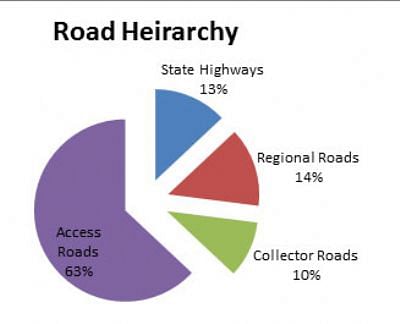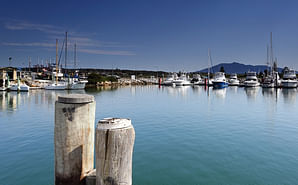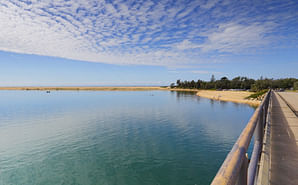Managing our roads
The shire's essential transport infrastructure which provides access and enables the efficient movement of people and goods within and through the Shire.
Council's Transport Network and Works Programs.
We're helping keep our community on the move
The Bega Valley Shire Council delivers and maintains the Shire's essential transport infrastructure. The excellent network of roads and related facilities provides access to public and private properties and enables the efficient movement of people and goods within and through the Shire. All at agreed, high-service levels and at the optimum life-cycle cost. The substantial network of assets, owned and managed by Bega Valley Shire Council, includes:
- 705 kilometres of sealed roads;
- 715 kilometres of unsealed roads;
- 227 bridges;
- 61 kilometres of footpaths; and
- 9 kilometres of cycle ways and associated drainage structures.
The 1,420 kilometre road network is valued at $191 million and is the Council's major physical asset. It costs $5.2 million a year to operate (excluding bridge costs) which represents 14 percent of annual revenue from rates.
How do we measure the Network's cost?
There are two key transport service costs:
- The average annual cost over the life-cycle of the asset; and
- The total maintenance and capital renewal expenditure required.
Our clear plans for the future
Council takes very seriously its responsibility to maintain and, where possible, improve essential infrastructure and services.
To this end, we developed the following strategic objectives with respect to operating and maintaining the Shire's transport network.
They are:
- To ensure the network is kept at all times safe and functional, as set out in the Asset Management Plan.
- To develop and implement cost-effective log-term management strategies.
- To provide a precisely defined level of service and accurate monitoring of Council's performance.
Road Hierarchy
The Council’s adopted road hierarchy is broken down in order of each road type's relative importance and cost.
State Highways. (such as the Princes and Snowy Mountains Highways)
These are managed, maintained and funded by the RTA.
They include:
- Roads with State significance.
- Roads with high-traffic volumes and/or which cater for long-distance travel.
- Are the principal avenue of communication between capital cities, major regions and key towns
- Are roads on which through traffic and heavy vehicles predominate.
Regional Roads
These are owned and managed by Council as determined by the RTA.
They are typically Main Roads and Regional Roads.
RTA provides maintenance (Block Grant) and renewal (REPAIR Grant) funding.
The regional roads usually have the following six characteristics;
- They are less important than State Highways but still vital at a regional level.
- They are usually part of alternate route network such as an arterial road.
- They link a larger population or activity centres.
- They carry significant through-traffic, including heavy vehicles.
- Significant tourist/visitor traffic is carried on them.
- They provide key social and economic links.
Collector Roads
These are managed, maintained and funded by Council and can be both urban (such as Auckland Street, Monaro Street and Wallaga Street) and rural (Dr George Mountain Road, Upper Brogo Road and Burragate Road).
They have the following seven functional characteristics;
- They tend to link higher order roads.
- They connect population or activity centres.
- They are usually part of a loop road.
- They carry significant through-traffic.
- They provide critical access.
- They carry significant traffic volumes.
- They enable and support economic development.
Local Access Roads
These are also managed, maintained and funded by Council.
All remaining roads that do not meet the requirements for a Collector Road classification fall into this classification, and perform the following three functions;
- They predominantly cater for local, short-distance travel and access to abutting property.
- They provide local access by connecting users to the local collector roads, regional roads or State highways.
- They provide almost exclusively for one activity or function.
Other Road Authority Roads
There is an extensive network of NPWS and NSW Forestry roads throughout the Shires' National Park and Forestry estates.
It is to be noted that two Forestry Roads provide a vital east-west link within the Shire south of Eden.
These roads are;
- Edrom Road, which links the Princes Highway to the Eden woodchip mill, multipurpose wharf and JALO; and
- Imlay Road, which links Monaro Highway, to the Princess Highway primarily to facilitate the hauling of timber.

There are also Crown Roads and Forestry Roads within the Shire. These are not owned, maintained or managed by Council.
The Council’s unsealed road network has been further divided into the following road hierarchies:
'C' class unsealed roads.
- Three maintenance-grades per year.
- All school bus and/or milk tanker routes.
- Arterial roads with greater traffic.
'B' class unsealed roads.
- One maintenance grade per year.
- Smaller collector roads with low traffic.
'A' class unsealed roads.
- Not maintained by Council.
This hierarchy was introduced to provide a higher level of service on school bus and milk tanker routes, and on arterial roads.
The hierarchy also helps the Council to better match an achievable level of service to the available budget.
There are approximately 30 kilometres of unsealed urban streets to maintain.
Transport Asset Quantities - A brief Summary
The following summary is set out out in Asset Group, Asset Description and Asset Quantity:
Regional Roads
- Sealed - 234.6km
- Unsealed - 18.9km
Collector Roads: Urban
- Sealed - 40.9km
Collector Roads: Rural
- Sealed - 130.1km
- Unsealed - 60.6km
Access Roads: Urban
- Sealed - 193.75km
- Unsealed - 22.10km
- Formed natural - 0km
- Unformed natural (no maintenance) - 16.32km
Access Roads: Rural
- Sealed - 175.27km
- Unsealed - 271.03km
- Formed natural - 332.04km
- Unformed natural (no maintenance) - 112.39km
Kerb and Gutter
- 281.78km
Roadside General
- Signs - 4,624No
- Guardrail - 33.334km
- Lighting - 2,675No
- Bus Shelters - 40No
Bridges
- Timber Local - 45No
- Timber Regional - 7No
- Non Timber Local - 120No
- Non Timber Regional - 63No
- Causeways Concrete Local - 56No
Drainage
- Pits - 5,950No
- Pipes - 109.15km
- Basins - 22No
Foot Paving
- Concrete - 56.034km
- Paved - 4.57km
Cycleways
- Concrete - 6.289km
- 2.974km
Carparks
- On Street - 1,503 spaces
- Off Street - 5,369 spaces
Road maintenance - protecting our most valuable assets
There are several types of maintenance required.
Sealed roads
Bitumen Maintenance is not simply about filling in potholes.
The operation includes pavement patching, heavy patching, reseals, drain cleaning and guide posting.
Council has two jetpatchers, one is a 6m3 patcher used for rural bitumen patching, and the 4m3 patcher is used for urban patching.
Both of the jetpatcher crews work on a routine schedule.
Urgent repairs are programmed into the routine schedule and these are identified by the Road Asset Inspector and the Bitumen Team Leader.
The jetpatcher also carries out at least one private job per week.
Heavy patching is carried out using a milling attachment on a bobcat.
A contract broom truck is hired for one day per week to sweep the pavement repaired by the heavy patching and jetpatcher.
Heavy patching and jetpatcher crews are also responsible for all repairs and are required to prepare the pavement for the reseal programs.
The boom mower that works on the gravel roads, removing vegetation during winter, also slashes the road shoulders on the bitumen roads during spring, summer and autumn.
There is also a second slasher which assists with shoulder-slashing and carries out urban area 'heavy' mowing and fire break maintenance.
Resealing
The purpose of a bitumen seal is to provide a waterproof, dust-free wearing surface over the structural layers of the road, such as the pavement.
If Council's reseal budget is maintained at the desired level it will eventually allow the introduction of more specialised sealing techniques.
This may be more expensive in the short-term but will provide an improved result in the longer term
- Program: Urban Reseals
Desired Reseal Cycle - 15 years - Program: Rural Reseals
Desired Reseal Cycle - 12 years - Program: MR Reseals
Desired Reseal Cycle - 12 years
Pavement rehabilitation
The RTA recommend that approximately three percent (3%) of the network be rehabilitated annually.
Council currently rehabilitates around 0.5% of the Local road network annually.
Roadside furniture
Roadside furniture is a general term for anything other than the road pavement and formation.
It includes line marking, signage, guard rails and chain wire fences, as well as guideposts.
The funding for this is provided mostly by the Traffic Facilities component of the Regional Road Block Grant.
Unsealed roads' upkeep
Gravel maintenance is not just grading the unsealed roads.
The operation includes maintenance-grading, gravel resheeting, drain maintenance, scrub cutting and installing guide posts.
The gravel maintenance operation is carried out by three graders, each grading approximately one third of the Shire's road network.
Each grader is accompanied by a water truck and roller.
The grader teams generally carry out the gravel within their areas.
There is a backhoe tip-truck combination to clean drains.
The boom mower works on the gravel roads removing vegetation during the winter months.
The teams work 8.5 hours per day over a 9-day fortnight.
The total available budget is therefore a combination of individual budgets.
Gravel resheeting
The purpose of resheeting on gravel roads is to replace pavement material that is lost due to traffic abrasion, climatic conditions (wind and rain) and cover-poor natural surfaces such as clay.
A desirable resheeting cycle is 8 years. Funds available for resheeting on gravel roads totals $595,000. Generally, only ‘C’ Class roads are gravel resheeted. This produces a resheeting cycle of 13 years.
Currently there is no resheeting done on 'B' class roads, which accounts for 50 percent of the Council's road network.
Gravel requirements
Council requires approximately 40,000m3 of gravel per annum for resheeting and new sealing works.
Whilst gravel costs are reasonable at the source, the real cost is in the haulage.
Council currently has access to a number of established pits which provide gravel for sealing and resheeting works.
Council also has a number of sites where road realignment works are being carried out and in the process gravel is being won.
Water requirements
The Office of Water requires Council to licence all the locations from which it draws water for road maintenance and construction purposes.
Council has identified all of its water points, 130 in total, and these have been provided to the relevant authorities .
Road Funding
There are two major sources:
Council sources, comprising:
- General Fund - your rates.
- Loans - money borrowed by Council for capital works projects.
- Section 94 Funds - developer contributions to upgrading of Council roads servicing their development.
External sources:
- Repair:
This is a State government grant.
It's objectives are to provide additional assistance to Council to undertake larger works of rehabilitation, and development on regional roads to minimise the long term maintenance costs of the road.
These grants are 50 percent Council funded and 50 percent State Government. - Roads to Recovery:
This is a Federal Government grant created due to the deterioration of rural roads.
The purpose of the grant is to restore aging road infrastructure.
These grants are 100 percent Federal Government-funded. - RTA Block Grant:
This is a State Government grant for the maintenance of regional roads.
This is made up of a roads and a traffic facilities component and the old 3 x 3 grant.
These grants are 100 percent State Government-funded.
Footpaths
Trip hazards
- Funded by Council's general fund (your rates).
- Funds are allocated every year to remove identified trip hazards in the footpath network.
- Footpath trip hazards can be removed by grinding down the footpath surface or replacing the old footpath with a new section of footpath.
Footpath construction
- The Footpath Capital Works Program is funded 50 percent by adjacent property owners and 50 percent by Council, and this comes from the general fund.
Kerbing and guttering
Kerb and gutter construction:
- The kerb and gutter capital works program is funded 50 percent by adjacent property owners and 50 percent by Council, and this comes from general fund.
Road and street upgrade strategy
Like the maintenance operation, the upgrading of rural roads and urban streets is funded by a number of sources. These are summarised under the following programs:
FAG rural Sealed Const
- Funding Source: Grant
- Project description: 1 project/year - Collector unsealed rural road sealing
- Prioritisation Method: Point Score System
Roads to Recovery
- Funding Source: Grant
- Project description: $430,00 gravel resheeting; $230,00 bridge rehab; $70,00 sealed road rehab
- Prioritisation Method: Staff
FAG Rehab Rural Unsealed
- Funding Source: Grant
- Project description: Various gravel resheeting projects
- Prioritisation Method: Staff
FAG Rehab Rural Sealed
- Funding Source: Grant
- Project description: Various heavy patching projects
- Prioritisation Method: Staff
FAG Rehab Urban Sealed
- Funding Source: Grant
- Project description: Various heavy patching projects
- Prioritisation Method: Staff
Rural Sealed Construction
- Funding Source: Section 94 Developer Contribution
- Project description: Various improvements between development and nearest major sealed road. Funds spent in area where they are received.
- Prioritisation Method: Section 94 Plan / Staff
Repair
- Funding Source: Grant/ Loan
- Project description: Rehabilitation of sealed Regional Road
- Prioritisation Method: Staff / RTA / Council
Urban Sealed Construction
- Funding Source: Loan
- Project description: Sealing urban streets in rural villages
- Prioritisation Method: Point Score System
Urban Stormwater Construction
- Funding Source: Loan
- Project description: Major urban drainage projects
- Prioritisation Method: Point Score System
Kerb and Gutter Construction
- Funding Source: Council
- Project description: New kerb and gutter construction
- Prioritisation Method: Point Score System
Footpath Construction
- Funding Source: Council
- Project description: New footpath construction
- Prioritisation Method: Point Score System
Urban Reseals
- Funding Source: Council
- Project description: Reseal aged pavement
- Prioritisation Method: Staff
Rural Reseals
- Funding Source: Council
- Project description: Reseal aged pavement
- Prioritisation Method: Staff
MR Block Grant
- Funding Source: Grant
- Project description: Maintenance and Improvements to Regional Roads
- Prioritisation Method: Staff






